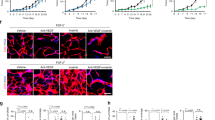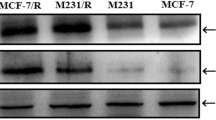Abstract
A breast cancer-selective oncolytic adenovirus was engineered to express antagonists of vascular endothelial growth factor (VEGF) and Notch signaling to combine direct anticancer activity with disruption of tumor-associated angiogenesis. Replication of the parental virus, AdEHE2F, is stimulated by estrogen receptor (ER), E2F1 and hypoxia, and it mediates selective lysis of breast cancer cells in vitro and in vivo. Here, we encoded soluble Flt-1 (sFlt1) and soluble Dll4 (sDll4) under control of the E3 promoter. sFlt1 (the extra-cellular domain of VEGF receptor 1) binds VEGF-A and inhibits stimulation of VEGFR2, decreasing angiogenic stimulus. Conversely, sDll4 (the extracellular domain of Delta-like 4) antagonizes Notch signaling to prevent endothelial maturation. We hypothesized that these agents might show additive or synergistic activity. In vitro, sFlt1 inhibited endothelial cell proliferation and sprouting, whereas sDll4 increased the number of vascular branchpoints. In ER-positive ZR75.1 tumors in vivo AdEHE2F showed the potent direct virotherapy with no augmentation owing to sFlt1 or sDll4; however, in ER-negative MDA-231 tumors efficacy was enhanced by encoding sFlt1 or sDll4, with survival time extending to double that of controls. There was also a dramatic decrease in the total number of tumour blood vessels, as well as the number of perfused vessels, suggesting that improved efficacy reflects combined anti-tumour and anti-vascular effects.
This is a preview of subscription content, access via your institution
Access options
Subscribe to this journal
Receive 12 print issues and online access
$259.00 per year
only $21.58 per issue
Buy this article
- Purchase on Springer Link
- Instant access to full article PDF
Prices may be subject to local taxes which are calculated during checkout





Similar content being viewed by others
References
Tai-Ping D, Fan ECK . The New Angiotherapy. Humana Press, 2001.
Dvorak HF . Angiogenesis: update 2005. J Thromb Haemost 2005; 3: 1835–1842.
Ferreira AK, Freitas VM, Levy D, Ruiz JL, Bydlowski SP, Rici RE et al. Anti-angiogenic and anti-metastatic activity of synthetic phosphoethanolamine. PLoS ONE 2013; 8: e57937.
Awazu Y, Mizutani A, Nagase Y, Tsuchiya S, Nakamura K, Kakoi Y et al. Anti-angiogenic and anti-tumor effects of TAK-593, a potent and selective inhibitor of vascular endothelial growth factor and platelet-derived growth factor receptor tyrosine kinase. Cancer Sci 2013; 104: 486–494.
Porta C, Paglino C, Imarisio I, Bonomi L . Uncovering Pandora's vase: the growing problem of new toxicities from novel anticancer agents. The case of sorafenib and sunitinib. Clin Exp Med 2007; 7: 127–134.
Small EJ, Carducci MA, Burke JM, Rodriguez R, Fong L, van Ummersen L et al. A phase I trial of intravenous CG7870, a replication-selective, prostate-specific antigen-targeted oncolytic adenovirus, for the treatment of hormone-refractory, metastatic prostate cancer. Mol Ther 2006; 14: 107–117.
Liu TC, Galanis E, Kirn D . Clinical trial results with oncolytic virotherapy: a century of promise, a decade of progress. Nat Clin Pract Oncol 2007; 4: 101–117.
Russell SJ, Peng KW, Bell JC . Oncolytic virotherapy. Nat Biotechnol 2012; 30: 658–670.
Alemany R . Cancer selective adenoviruses. Mol Aspects Med 2007; 28: 42–58.
Hakkarainen T, Hemminki A, Curiel DT, Wahlfors J . A conditionally replicative adenovirus that codes for a TK-GFP fusion protein (Ad5Delta24TK-GFP) for evaluation of the potency of oncolytic virotherapy combined with molecular chemotherapy. Int J Mol Med 2006; 18: 751–759.
Fuerer C, Iggo R . 5-Fluorocytosine increases the toxicity of Wnt-targeting replicating adenoviruses that express cytosine deaminase as a late gene. Gene Ther 2004; 11: 142–151.
Mi J, Li ZY, Ni S, Steinwaerder D, Lieber A . Induced apoptosis supports spread of adenovirus vectors in tumors. Hum Gene Ther 2001; 12: 1343–1352.
Liu BL, Robinson M, Han ZQ, Branston RH, English C, Reay P et al. ICP34.5 deleted herpes simplex virus with enhanced oncolytic, immune stimulating, and anti-tumour properties. Gene Ther 2003; 10: 292–303.
Zhao L, Dong A, Gu J, Liu Z, Zhang Y, Zhang W et al. The antitumor activity of TRAIL and IL-24 with replicating oncolytic adenovirus in colorectal cancer. Cancer Gene Ther 2006; 13: 1011–1022.
Thorne SH, Tam BY, Kirn DH, Contag CH, Kuo CJ . Selective intratumoral amplification of an antiangiogenic vector by an oncolytic virus produces enhanced antivascular and anti-tumor efficacy. Mol Ther 2006; 13: 938–946.
Zhang Z, Zou W, Wang J, Gu J, Dang Y, Li B et al. Suppression of tumor growth by oncolytic adenovirus-mediated delivery of an antiangiogenic gene, soluble Flt-1. Mol Ther 2005; 11: 553–562.
Li GC, Yang JM, Nie MM, Su CG, Sun LC, Qian YZ et al. Potent antitumoral effects of a novel gene-viral therapeutic system CNHK300-mEndostatin in hepatocellular carcinoma. Chin Med J (Engl) 2005; 118: 179–185.
Li G, Sham J, Yang J, Su C, Xue H, Chua D et al. Potent antitumor efficacy of an E1B 55kDa-deficient adenovirus carrying murine endostatin in hepatocellular carcinoma. Int J Cancer 2005; 113: 640–648.
Kendall RL, Wang G, Thomas KA . Identification of a natural soluble form of the vascular endothelial growth factor receptor, FLT-1, and its heterodimerization with KDR. Biochem Biophys Res Commun 1996; 226: 324–328.
Noguera-Troise I, Daly C, Papadopoulos NJ, Coetzee S, Boland P, Gale NW et al. Blockade of Dll4 inhibits tumour growth by promoting non-productive angiogenesis. Nature 2006; 444: 1032–1037.
Suchting S, Freitas C, le Noble F, Benedito R, Breant C, Duarte A et al. The Notch ligand Delta-like 4 negatively regulates endothelial tip cell formation and vessel branching. Proc Natl Acad Sci USA 2007; 104: 3225–3230.
Sainson RC, Harris AL . Anti-Dll4 therapy: can we block tumour growth by increasing angiogenesis? Trends Mol Med 2007; 13: 389–395.
Ridgway J, Zhang G, Wu Y, Stawicki S, Liang WC, Chanthery Y et al. Inhibition of Dll4 signalling inhibits tumour growth by deregulating angiogenesis. Nature 2006; 444: 1083–1087.
Li JL, Sainson RC, Shi W, Leek R, Harrington LS, Preusser M et al. Delta-like 4 Notch ligand regulates tumor angiogenesis, improves tumor vascular function, and promotes tumor growth in vivo. Cancer research 2007; 67: 11244–11253.
Carmeliet P, Ferreira V, Breier G, Pollefeyt S, Kieckens L, Gertsenstein M et al. Abnormal blood vessel development and lethality in embryos lacking a single VEGF allele. Nature 1996; 380: 435–439.
Duarte A, Hirashima M, Benedito R, Trindade A, Diniz P, Bekman E et al. Dosage-sensitive requirement for mouse Dll4 in artery development. Genes Dev 2004; 18: 2474–2478.
Mahasreshti PJ, Navarro JG, Kataram M, Wang MH, Carey D, Siegal GP et al. Adenovirus-mediated soluble FLT-1 gene therapy for ovarian carcinoma. Clin Cancer Res 2001; 7: 2057–2066.
Bazan-Peregrino M, Carlisle RC, Hernandez-Alcoceba R, Iggo R, Homicsko K, Fisher KD et al. Comparison of molecular strategies for breast cancer virotherapy using oncolytic adenovirus. Hum Gene Ther 2008; 19: 873–886.
Hernandez-Alcoceba R, Pihalja M, Qian D, Clarke MF . New oncolytic adenoviruses with hypoxia- and estrogen receptor-regulated replication. Hum Gene Ther 2002; 13: 1737–1750.
Goonewardene TI, Sowter HM, Harris AL . Hypoxia-induced pathways in breast cancer. Microsc Res Tech 2002; 59: 41–48.
Glass AG, Lacey JV Jr., Carreon JD, Hoover RN . Breast cancer incidence, 1980-2006: combined roles of menopausal hormone therapy, screening mammography, and estrogen receptor status. J Natl Cancer Inst 2007; 99: 1152–1161.
Kong HL, Hecht D, Song W, Kovesdi I, Hackett NR, Yayon A et al. Regional suppression of tumor growth by in vivo transfer of a cDNA encoding a secreted form of the extracellular domain of the flt-1 vascular endothelial growth factor receptor. Hum Gene Ther 1998; 9: 823–833.
Nakatsu MN, Sainson RC, Aoto JN, Taylor KL, Aitkenhead M, Perez-del-Pulgar S et al. Angiogenic sprouting and capillary lumen formation modeled by human umbilical vein endothelial cells (HUVEC) in fibrin gels: the role of fibroblasts and Angiopoietin-1. Microvasc Res 2003; 66: 102–112.
Tomayko MM, Reynolds CP . Determination of subcutaneous tumor size in athymic (nude) mice. Cancer Chemother Pharmacol 1989; 24: 148–154.
Bazan-Peregrino M, Carlisle RC, Purdie L, Seymour LW . Factors influencing retention of adenovirus within tumours following direct intratumoural injection. Gene Ther 2008; 15: 688–694.
Sainson RC, Aoto J, Nakatsu MN, Holderfield M, Conn E, Koller E et al. Cell-autonomous notch signaling regulates endothelial cell branching and proliferation during vascular tubulogenesis. Faseb J 2005; 19: 1027–1029.
Hellstrom M, Phng LK, Hofmann JJ, Wallgard E, Coultas L, Lindblom P et al. Dll4 signalling through Notch1 regulates formation of tip cells during angiogenesis. Nature 2007; 445: 776–780.
Peng Z . Current status of gendicine in China: recombinant human Ad-p53 agent for treatment of cancers. Hum Gene Ther 2005; 16: 1016–1027.
Yu W, Fang H . Clinical trials with oncolytic adenovirus in China. Curr Cancer Drug Targets 2007; 7: 141–148.
Hawkins LK, Johnson L, Bauzon M, Nye JA, Castro D, Kitzes GA et al. Gene delivery from the E3 region of replicating human adenovirus: evaluation of the 6.7 K/gp19 K region. Gene Ther 2001; 8: 1123–1131.
Hawkins LK, Hermiston TW . Gene delivery from the E3 region of replicating human adenovirus: evaluation of the ADP region. Gene Ther 2001; 8: 1132–1141.
Mahasreshti PJ, Kataram M, Wang MH, Stockard CR, Grizzle WE, Carey D et al. Intravenous delivery of adenovirus-mediated soluble FLT-1 results in liver toxicity. Clin Cancer Res 2003; 9: 2701–2710.
Kim KJ, Li B, Winer J, Armanini M, Gillett N, Phillips HS et al. Inhibition of vascular endothelial growth factor-induced angiogenesis suppresses tumour growth in vivo. Nature 1993; 362: 841–844.
Rudge JS, Thurston G, Davis S, Papadopoulos N, Gale N, Wiegand SJ et al. VEGF trap as a novel antiangiogenic treatment currently in clinical trials for cancer and eye diseases, and VelociGene- based discovery of the next generation of angiogenesis targets. Cold Spring Harb Symp Quant Biol 2005; 70: 411–418.
Casanovas O, Hicklin DJ, Bergers G, Hanahan D . Drug resistance by evasion of antiangiogenic targeting of VEGF signaling in late-stage pancreatic islet tumors. Cancer Cell 2005; 8: 299–309.
Jain RK, Duda DG, Clark JW, Loeffler JS . Lessons from phase III clinical trials on anti-VEGF therapy for cancer. Nat Clin Pract Oncol 2006; 3: 24–40.
Segarra M, Williams CK, Sierra Mde L, Bernardo M, McCormick PJ, Maric D et al. Dll4 activation of Notch signaling reduces tumor vascularity and inhibits tumor growth. Blood 2008; 112: 1904–1911.
Acknowledgements
We gratefully acknowledge the support of the Clarendon Fund, Balliol and Magdalen Colleges, University of Oxford and the Consejo Nacional de Ciencia y Tecnologia (CONACYT) (MBP), European Union (RCC, LSHB-CT-2004-512087) and Cancer Research UK (LWS), technical histology services provided by Louise Young and Hilary Brown, and Fionnadh Carroll for technical support in animal experimentation.
Author information
Authors and Affiliations
Corresponding author
Ethics declarations
Competing interests
The authors declare no conflict of interest.
Rights and permissions
About this article
Cite this article
Bazan-Peregrino, M., Sainson, R., Carlisle, R. et al. Combining virotherapy and angiotherapy for the treatment of breast cancer. Cancer Gene Ther 20, 461–468 (2013). https://doi.org/10.1038/cgt.2013.41
Received:
Accepted:
Published:
Issue Date:
DOI: https://doi.org/10.1038/cgt.2013.41



